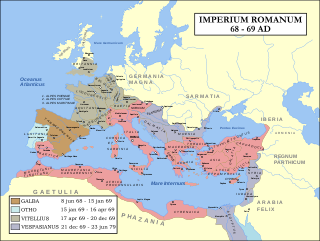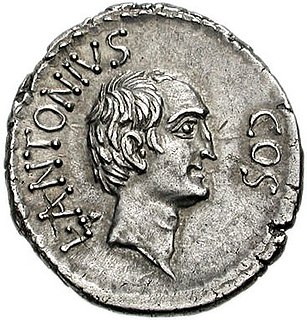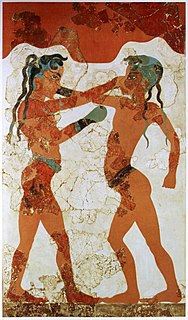Related Research Articles

AD 69 (LXIX) was a common year starting on Sunday of the Julian calendar. At the time, it was known as the Year of the Consulship of Augustus and Rufinus. The denomination AD 69 for this year has been used since the early medieval period, when the Anno Domini calendar era became the prevalent method in Europe for naming years.
A saeculum is a length of time roughly equal to the potential lifetime of a person or, equivalently, the complete renewal of a human population. Originally it meant the time from the moment that something happened until the point in time that all people who had lived at the first moment had died. At that point a new saeculum would start. According to legend, the gods had allotted a certain number of saecula to every people or civilization; the Etruscans, for example, had been given ten saecula.

A periplus, or periplous, is a manuscript document that lists the ports and coastal landmarks, in order and with approximate intervening distances, that the captain of a vessel could expect to find along a shore. In that sense, the periplus was a type of log and served the same purpose as the later Roman itinerarium of road stops. However, the Greek navigators added various notes, which, if they were professional geographers, as many were, became part of their own additions to Greek geography.

Lucius Antonius was the younger brother and supporter of Mark Antony, a Roman politician. He was nicknamed Pietas as a young man.

Gnaeus Pompeius Magnus was a Roman politician and general from the late Republic.

The vigintisexviri were a college (collegium) of minor magistrates in the Roman Republic. The college consisted of six boards:
The interrex was literally a ruler "between kings" during the Roman Kingdom and the Roman Republic. He was in effect a short-term regent.
Oikonomos, latinized œconomus, oeconomus, or economos, was an Ancient Greek word meaning "household manager." In Byzantine times, the term was used as a title of a manager or treasurer of an organization.
Vibius Sequester is the Latin author of lists of geographical names.
Gaius Calpurnius Piso was a politician and general from the Roman Republic. He became praetor urbanus in 72/71 BC. After being elected consul in 67 BC, Piso opposed Pompeius' friends, the tribunes Gaius Cornelius and Aulus Gabinius. Assigned both Gallia Narbonensis and Gallia Cisalpina, he remained as proconsul until 65, or perhaps later in Cisalpina. Piso defeated an Allobrogian rebellion and repressed troubles in Transpadana, for which he was unsuccessfully prosecuted by Caesar. He supported Cicero during the Catiline conspiracy.

The Battle of the Great Plains, also known as the Battle of the Bagrades or the First Battle of the Bagradas, was a battle between a Roman army commanded by Scipio Africanus and a combined Carthaginian-Numidian army late in the Second Punic War. It was fought on the plains south of Bulla Regia around the upper Bagradas River. The African campaign of Scipio was designed as a diversionary tactic by Rome to disrupt Hannibal's attack on Italy. By defeating the Carthaginians, Scipio Africanus caused Hannibal to leave Italy and return to Africa, where he was later defeated at Zama.
The Boedromia (Βοηδρόμια) was an ancient Greek festival held at Athens on the 7th of Boedromion (summer) in the honor of Apollo Boedromios. Though Apollo was referred to as Boedromios by the Boeotians as well as other Greeks, the festival was exclusively celebrated by the Athenians. According to Demosthenes, the only classical writer to refer to the festival, it had a military connotation, and thanks the god for his assistance to the Athenians during wars. It could also commemorate a specific intervention at the origin of the festival. Various ancient sources have offered differing accounts on what this intervention may have been. According to Plutarch, Theseus refused to battle against the Amazons until he had sacrificed to Phobos. It is in recognition of the help granted in the ensuing battle that the Athenians celebrate the festival. However, the Suda and Euripides report that the festival's origins lie in the help either Xuthos or his son Ion granted to the Athenians when they were attacked by Eumolpos during the reign of Erechtheus. During the event, sacrifices were also made to Artemis Agrotera.
The Second Messenian War was a war which occurred ca. 660–650 BC between the Ancient Greek states of Messenia and Sparta, with localized resistance possibly lasting until the end of the century. It started around 40 years after the end of the First Messenian War with the uprising of a slave rebellion. Other scholars, however, assign earlier dates, claiming, for example, that 668 BC is the date of the war's start, pointing at Sparta's defeat at the First Battle of Hysiae as a possible catalyst for the uprising. Current events concerning this war are stated, too.
The Salassi or Salasses were a Gallic or Ligurian tribe dwelling in the upper valley of the Dora Baltea river, near present-day Aosta, during the Iron Age and the Roman period.
Marcellinus was the author of a Life of Thucydides, found in some of the ancient commentaries on the History of the Peloponnesian War by Thucydides. Nothing else is known for certain about this Marcellinus, but he probably lived in about the 6th century AD, and compiled his biography from passages in early writers, adding his own observations. Because he lived so long after Thucydides, the statements of Marcellinus must be treated with caution unless they are supported by other evidence.
Theodorus of Samos was a 6th-century BC ancient Greek sculptor and architect from the Greek island of Samos. Along with Rhoecus, he was often credited with the invention of ore smelting and, according to Pausanias, the craft of casting. He is also credited with inventing a water level, a carpenter's square, and, according to Pliny, a lock and key and the turning lathe. According to Vitruvius, Theodorus is the architect of the Doric order temple Heraion of Samos temple. In some texts he is described, above all, as a great artist and in some statues he is depicted as a great inventor.

The Minoan civilization in the Bronze Age was located on the island of Crete. Focusing on the palatial periods between c. 1900 and c. 1300 b.c.. Art that focuses on just scenes of war alone is impossible as there are many other references that can be made not relating to war at all. There are various meanings that can be interpreted from different perspectives and that is what Molloy wants readers to understand. There could be an overlap of religion, politics, social meanings added to an iconography of warfare. “Practitioners of violence” are called warriors, just an identity who performed their social acts depending on their society. These social acts ranges from bull-leaping, boxing, hunting, sports, combat, fighting and more. Malloy divides the art relating to warfare in Bronze Age Crete into four categories “glyptic art circulating in both social and administrative contexts; stone and ceramic portable art for repeated intimate consumption (dining/processions); coroplastic/bronze figural art for religious activity; and frescoes and relief mouldings fixed in architectural settings”.
Auctions in ancient Greece were are events in which goods were sold through an open bidding process between multiple buyers, the highest bidder receiving the goods. In a public auction, goods belonging to the state were sold, whereas private auctions sold goods belonging to individuals and identity of the seller was private. Goods that were often sold at auction include, land, the ability to collect taxes, slaves, seized goods, and inheritances. Auctions have progressed to the exciting event we know today from a very long history that started in ancient Greece.
The Gallic Alps were an ancient cultural region located in the Alps and populated mainly by Gauls. The term Celtic Alps is also found in ancient Greek texts.
Quintus Caecilius Bassus was a Roman equestrian who fought during Caesar's civil war under Pompey before the Battle of Pharsalus. After the battle, he commandeered two mutinous legions in Syria and defended against a Caesarian siege at Apamea. There, he negotiated with Deiotarus, the king of Galatia, and the Parthians. After Caesar's death, both his men and those of his besiegers defected to Gaius Cassius Longinus; Bassus was then dismissed unharmed.
References
- ↑ Michael Crawford in Oxford Classical Dictionary, 2015 https://oxfordre.com/classics/view/10.1093/acrefore/9780199381135.001.0001/acrefore-9780199381135-e-143